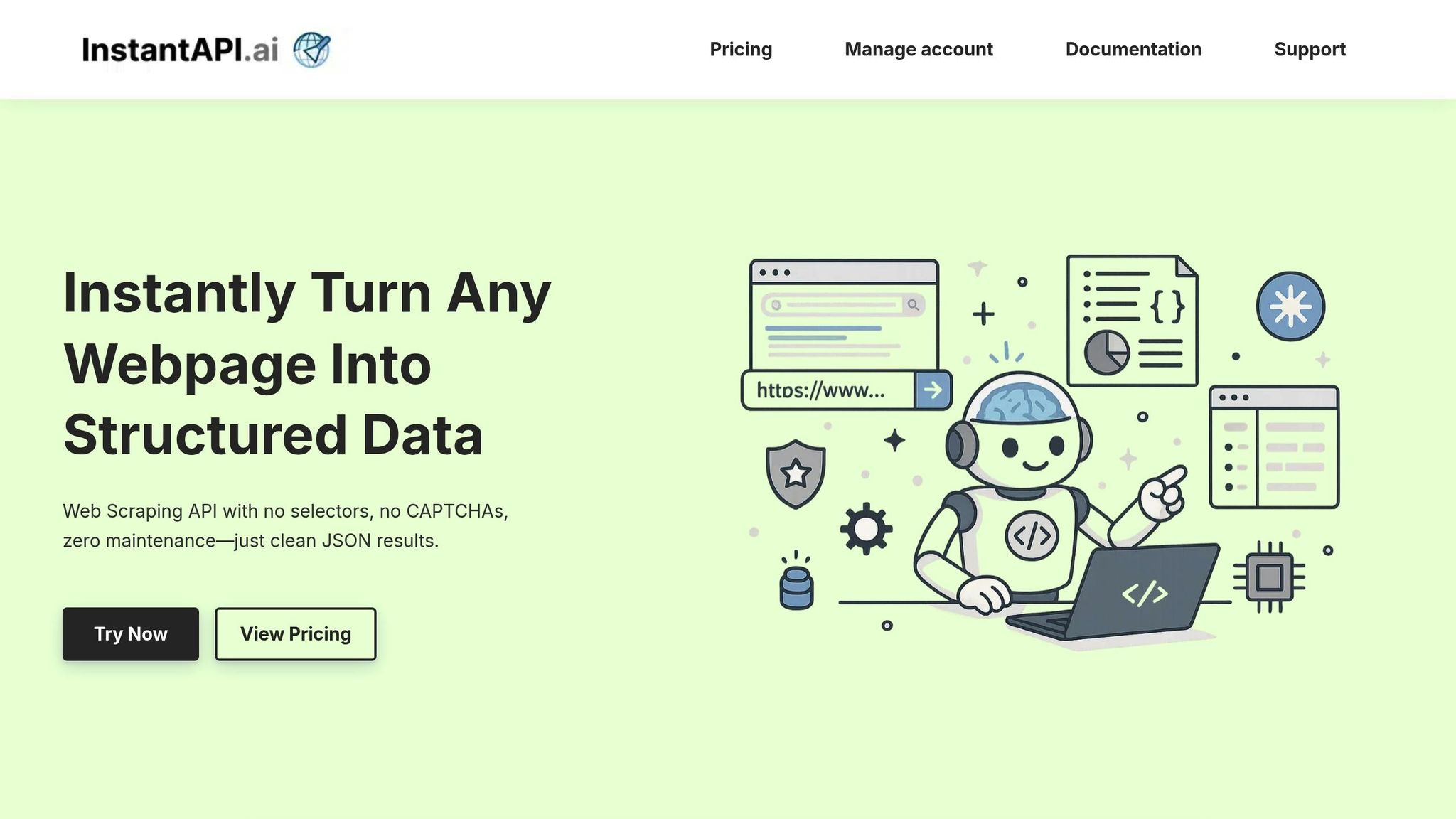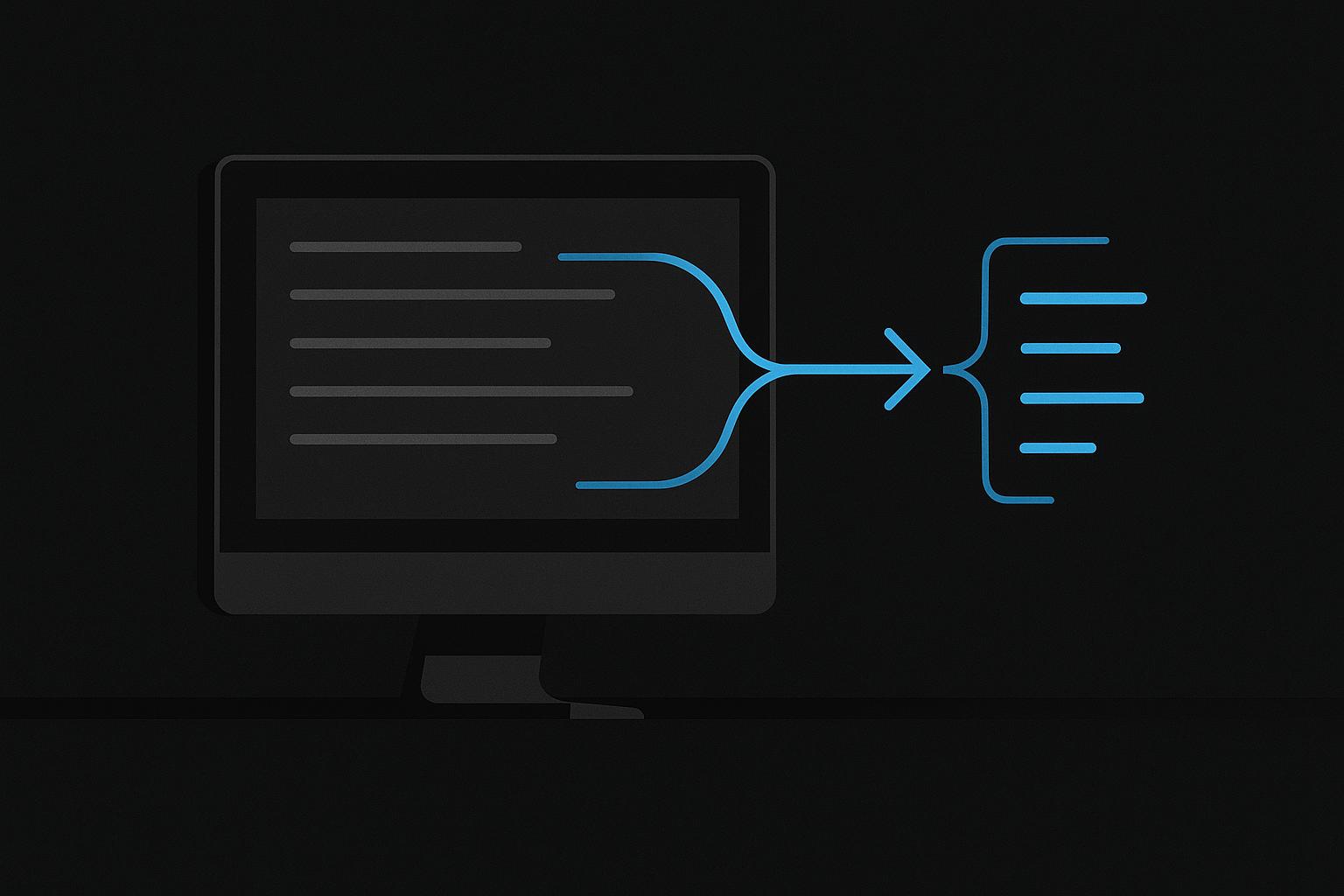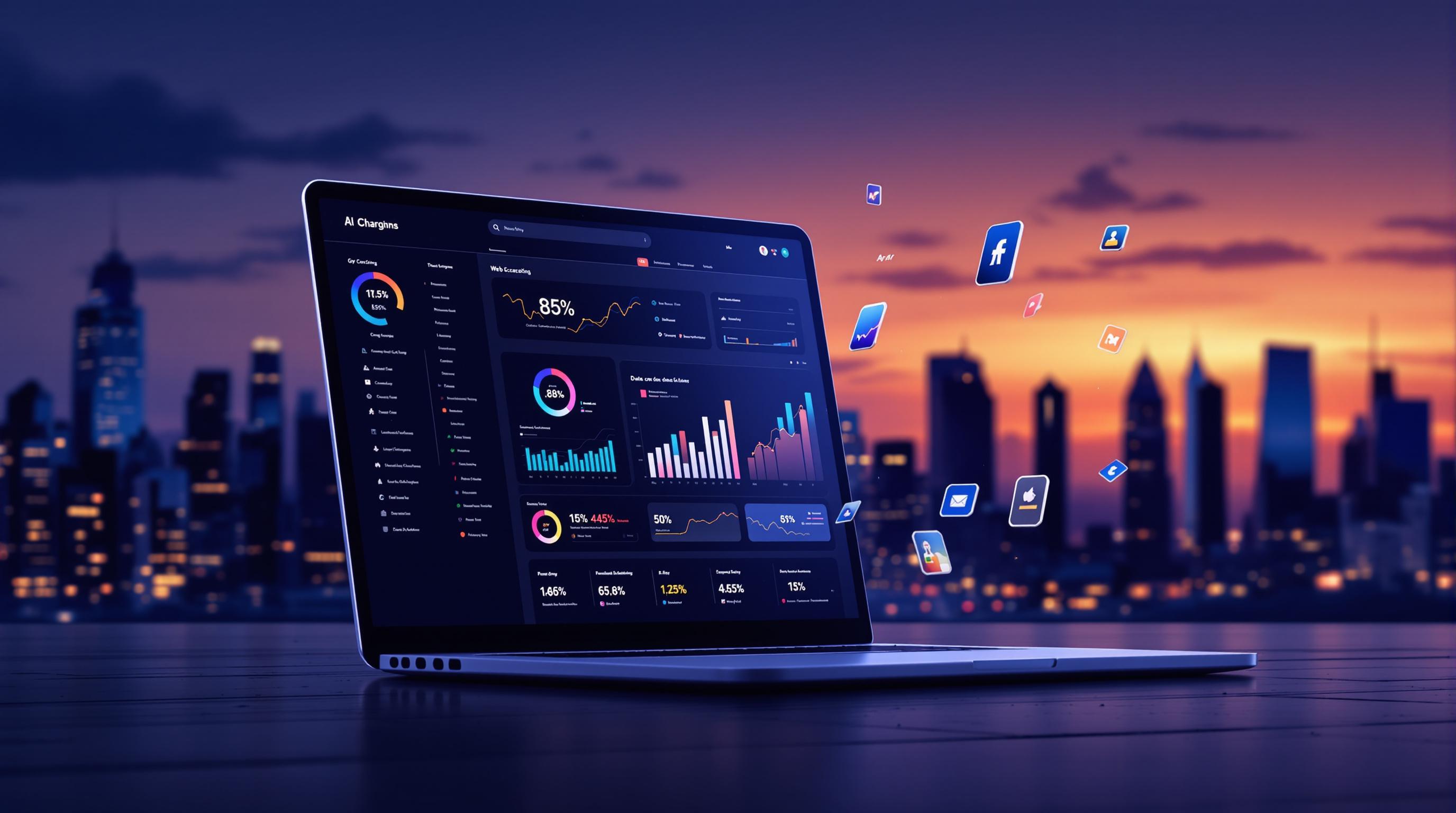Web scraping is changing how biotechnology collects and uses data. It automates the process of gathering information from websites, databases, and other digital sources, saving time and reducing errors. Here's what you need to know:
- Why it matters: Biotech generates massive amounts of data, with 80% remaining unstructured and hard to analyze. Automated tools like web scraping make it easier to process and use this data.
- Key uses: Pharmaceutical companies track clinical trials, patents, and regulations. Healthcare providers use it for patient care and epidemiological research.
- Challenges: Handling unstructured data, legal compliance, and integrating data from multiple sources are major hurdles.
- Solutions: AI-powered tools and APIs improve data extraction accuracy, speed, and compliance.
Web scraping is essential for managing biotech's growing data needs, driving faster research and better decision-making.
60-Minute Project | Biotech News Web Scraper With Python
Common Data Collection Barriers in Biotech
The biotechnology industry encounters distinct challenges when it comes to web scraping and data collection. These hurdles demand specialized approaches tailored to the complexities of biotech data.
Processing Unstructured Scientific Data
Handling unstructured data is a major obstacle in biotech. With over 200 data formats often generated by different vendors and instruments within a single company, the task of organizing and analyzing this information is daunting. In fact, around 80% of data in the life sciences sector remains unstructured, and only about 12% is successfully analyzed.
The volume of scientific data is growing rapidly, tripling annually. This includes a wide range of file types, such as:
- Clinical images
- Genome sequencing data
- Scientific articles
- Raw instrument readings
A great example of tackling this challenge comes from Pfizer. In 2023, they partnered with Komprise to analyze and migrate cold data to Amazon S3. This move not only saved them 75% on storage costs but also ensured that research teams could access the data whenever needed.
Meeting Legal Requirements
Navigating legal compliance adds another layer of complexity to biotech data collection. Companies must adhere to strict regulations, especially when dealing with sensitive health information, while still maintaining efficient data collection processes.
"During the development process, companies should take steps to understand how the technology will work in the consumer space or healthcare space, as well as what information the company will want to collect from consumers, and attempt to understand how that may change in the future." - Patricia M. Wagner, Chief Privacy Officer at Epstein Becker Green
To stay compliant, organizations should adopt measures like robust encryption, multi-factor authentication, and regular compliance audits to safeguard sensitive data.
The challenge grows when international data is involved. Studies show that risk-based regulatory systems process biotech assessments 63% faster than those influenced by socio-political factors (19.4 months versus 52.7 months). This underscores how regulatory frameworks can significantly impact data collection efficiency.
For companies working with multiple Contract Research Organizations (CROs), the complexity increases even further. Most global biopharmaceutical companies collaborate with 10 to 30 CRO/CDMO providers, each requiring unique data handling protocols and compliance standards. This adds another layer of intricacy to an already demanding process.
Web Scraping Methods for Biotech Data
The biotechnology industry deals with intricate scientific data that demands advanced collection techniques. Today, web scraping in this field often combines artificial intelligence with specialized tools to gather insights from diverse sources efficiently.
Machine Learning for Data Extraction
Machine learning has revolutionized how unstructured data is extracted in biotechnology. AI-driven tools can identify patterns and pull critical details from sources like scientific papers, patents, and research databases.
For example, a major pharmaceutical company deployed an AI-powered platform to automate the collection of clinical data from government registries, peer-reviewed journals, and corporate press releases. This system led to:
- 70% faster data collection
- Improved accuracy in extracting critical information
- Better competitive insights
- Lower research operation costs
This success relied on two key technologies:
- Advanced HTML parsing, which adapts to evolving website structures
- Dynamic fingerprinting systems, designed to bypass blocking mechanisms during data collection
Managing Multi-Page Scientific Databases
Handling large, multi-page scientific databases presents its own challenges. To ensure data integrity and compliance, organizations need tailored strategies for integrating and managing multiple data sources.
| Data Source Type | Collection Method | Purpose |
|---|---|---|
| Public Records | Automated Scraping | Population Health Data |
| Healthcare Systems | API Integration | Clinical Records |
| Research Databases | Secure Data Transfer | Scientific Studies |
Key practices for managing such databases include:
- Scheduling tasks to avoid overwhelming servers
- Using rigorous data validation systems
- Storing both raw HTML and parsed data for quality checks
- Adhering to the terms of service for each data source
A centralized monitoring system is essential for maintaining data accuracy and addressing issues quickly. These strategies demonstrate how robust systems are critical for maintaining high standards in biotech data collection.
sbb-itb-f2fbbd7
Web Scraping Software for Biotech
Biotech research thrives on tools that can effectively gather and process scientific data. To handle the vast amount of information from various sources, specialized software becomes essential.
Using InstantAPI.ai for Biotech Data

InstantAPI.ai transforms complex biotech websites into structured APIs, making it easier for researchers to extract crucial data - no coding skills required.
Here’s how it supports biotech organizations:
| Feature | Application | Benefit |
|---|---|---|
| Real-time Analysis | Tracks new research publications | Ensures immediate access to discoveries |
| Structured Data Extraction | Converts unstructured lab data | Provides a standardized format for analysis |
| Custom API Generation | Integrates with internal systems | Enables seamless data flow across platforms |
The pricing model - $2 per 1,000 pages - offers a budget-friendly solution for organizations. While InstantAPI.ai excels at extracting data directly from websites, scientific APIs complement this by standardizing and validating the information.
Working with Scientific APIs
Scientific APIs play a crucial role in ensuring that biotech data is both accurate and compliant. They integrate seamlessly with databases while maintaining robust validation and secure access.
-
Database Integration
Standardizing data formats, ensuring secure transfers, and rigorously validating information are all part of the process. -
Access Management
Techniques like monitoring concurrent requests, implementing error handling, and setting timeouts for large data transfers help maintain efficiency.
With over 1,380 specialized databases in the biotechnology field - and more being added all the time - organizations face the challenge of balancing efficient data collection with strict compliance standards, all while ensuring smooth integration across platforms.
Data Quality and Legal Guidelines
Handling biotech data through web scraping demands not only advanced validation systems but also strict adherence to legal standards. A recent study highlights that 35% of information is lost between publication and repository entries, emphasizing the importance of rigorous validation. Below, we'll explore the key components of automated validation systems and the ethical frameworks necessary to safeguard data integrity.
Data Validation Systems
As biotech data continues to grow exponentially - from 4.4 zettabytes in 2013 to 44 zettabytes in 2020 - manual verification has become impractical. Automated validation systems are now essential to ensure data accuracy and consistency.
| Validation Layer | Purpose | Implementation Method |
|---|---|---|
| Data Integrity | Ensures accuracy and completeness | Laboratory Information Management System (LIMS) |
| Metadata Verification | Standardizes data categorization | Predefined metadata categories with URIs |
| Sample Tracking | Ensures chain-of-custody | Unique barcode system integration |
| Quality Control | Validates data consistency | Automated AI-powered checks |
For example, tools like UniTrack streamline data management by standardizing information across labs, automatically capturing data from lab equipment, and maintaining detailed audit trails. These systems play a critical role in preserving data integrity while keeping pace with the growing volume of information.
Legal and Ethical Data Collection
Beyond technical validation, complying with legal and ethical standards is equally important for maintaining data integrity.
"When your data is taken without permission and used in ways you haven't agreed to, that's not okay. On LinkedIn, our members trust us with their information, which is why we prohibit unauthorized scraping on our platform."
To align with these principles, organizations must implement the following measures:
- Data Protection: Use robust safeguards to secure sensitive information.
- Access Control: Enforce strict authentication protocols to limit access.
- Consent Management: Obtain explicit authorization for data collection and use.
Interestingly, research shows that 80% of industrial data goes unused due to technical, legal, and economic hurdles. To overcome these barriers, companies should adopt comprehensive data governance frameworks. This includes documenting data lineage, conducting regular compliance audits, and implementing secure storage solutions.
The adoption of FAIR principles - ensuring data is Findable, Accessible, Interoperable, and Reusable - is increasingly critical. These principles not only enhance the utility of collected data but also ensure compliance with privacy laws and regulatory standards.
Ultimately, success in biotech data management hinges on combining cutting-edge validation systems with unwavering legal and ethical practices. As technology and regulations evolve, organizations must stay ahead by continuously refining their approaches.
Conclusion: Advancing Biotech Through Data Collection
As we've explored, pushing the boundaries of biotech innovation hinges on efficient and compliant data collection. Recent advancements show that using proper web scraping methods can speed up research and development without compromising data accuracy or integrity.
"Data is the backbone of modern healthcare. It's important to have accurate and real-time data for effective healthcare management, from tracking disease outbreaks to personalizing patient care." - Naman Gupta, Author
The fusion of AI tools with ethical data practices is reshaping the landscape of biotech research. With the sheer volume of biotechnology data growing rapidly, automated solutions are becoming indispensable for managing the intricacies of biomedical research. These tools not only streamline processes but also ensure adherence to privacy laws and industry standards.
Here are the key elements driving this shift:
| Component | Impact | Future Outlook |
|---|---|---|
| AI Integration | Boosts accuracy in data extraction | Expanding automation for complex processes |
| Real-time Analytics | Speeds up research cycles | Incorporation of predictive modeling |
| Compliance Tools | Minimizes legal risks | Evolving to meet new regulatory requirements |
Biotechnology is at a pivotal point where effective data collection can unlock new possibilities. By leveraging advanced scraping technologies and prioritizing ethical standards, organizations can not only streamline their research efforts but also set the stage for future discoveries that could transform the field.
FAQs
How does web scraping help structure unorganized data in the biotechnology field?
Web scraping streamlines the task of managing unstructured data in biotechnology by automatically collecting information from diverse online sources, including research papers, clinical trial registries, and industry reports. Once gathered, this raw data is converted into structured formats, making it much simpler to analyze and incorporate into existing workflows.
Modern web scraping tools often leverage natural language processing (NLP) to interpret and classify text-based data. This allows researchers to draw valuable insights from massive datasets. These tools are particularly useful for tackling challenges like merging data from various sources and maintaining high data quality - key factors for advancing research, conducting market analysis, and tracking innovation within the biotech field.
What legal risks should biotechnology companies consider when using web scraping for data collection?
Biotechnology companies face several legal challenges when employing web scraping for data collection. One major concern is copyright infringement, as gathering content without proper authorization can breach intellectual property laws. Another significant risk comes from the Computer Fraud and Abuse Act (CFAA), which could apply if scraping involves bypassing security measures or violating a website's terms of service.
For companies handling sensitive health-related data, adhering to privacy regulations like HIPAA is non-negotiable to avoid hefty penalties or legal actions. Beyond legal compliance, ethical considerations play a crucial role - aggressive or questionable scraping methods can damage a company’s reputation and trustworthiness. To sidestep these risks, it’s wise to consult legal experts and ensure all practices comply with relevant laws and maintain ethical standards.
How do AI-powered tools improve web scraping for data collection in the biotechnology industry?
AI-powered tools are transforming web scraping in biotechnology by automating intricate tasks and boosting data precision. These tools rely on sophisticated algorithms to handle massive datasets at lightning speed, minimizing human error and ensuring the extraction of accurate and relevant information.
Take clinical trial recruitment as an example. AI can sift through medical records and genetic data to pinpoint eligible participants far more efficiently than traditional methods. On top of that, AI-driven web scraping tools can adjust automatically to changes in website structures. This eliminates the hassle of constant manual updates, saving valuable time while keeping data accurate and current - an absolute must for research, market analysis, and advancements in the biotech field.


